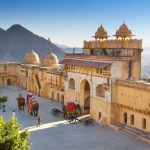Exploring the Heart of Delhi: A Inside Guide to Pragati Maidan
Welcome to Delhi the heart and capital of India. The bustling city is well known for its Historical Places In India, rich cultural significance, and history. Nestled in the heart of Delhi lies a sprawling complex that pulsates with the energy of innovation, creativity, and cultural richness. Pragati Maidan, a name that resonates with splendor and significance, stands as a beacon of progress amidst at the city’s bustling streets. In this blog, we embark on a journey to unravel the story behind Pragati Maidan – its history, architectural marvels, cultural significance, and economic impact, all of which contribute to its status as one of Delhi’s most iconic landmarks so that when you plan your next India tour packages make sure to visit this place.
History of Pragati Maidan
There are many historic places to visit in Delhi but Pragati Maidan holds a special place in the heart of Delhi. Pragati Maindan’s journey traces back to the post-independence era of India when the need for a centralized venue to host exhibitions, trade fairs, and cultural events became imperative. The entire layout of the complex was designed by the reputed architect Raj Rewal who also designed the other key buildings. It was Inaugurated in 1972 on November 3rd by Prime Minister Indira Gandhi, on the occasion of the International Trade Fair. Both the Pragati Maidan and Fair Trade were meant to celebrate the 25 years of India’s Independence.
Pragati Maidan emerged as a symbol of India’s aspirations for progress and development. Initially spread over 72 acres, the complex underwent expansions over the years, growing into the vast expanse that it is today. This massive complex overlooked the Old Fort or Purana Qila, and also once housed India’s first-ever theme park- the Appu Ghar.
Regrettably, following a period of political turmoil and contention, the historic Hall of Nations within Pragati Maidan met its demise in April 2017, as directed by the India Trade Promotion Organisation (ITPO). This decision was part of a larger initiative to transform Pragati Maidan into a modern convention and exhibition center. Alongside the Hall of Nations, other notable structures like the Nehru Pavilion and Industries Complex were also razed in the redevelopment process.
Architectural Marvels
One cannot talk about Pragati Maidan without marveling at its architectural splendor. The complex is adorned with iconic structures that blend modern design with traditional elements. Renowned architects such as Raj Rewal and Kuldip Singh have left their indelible mark on Pragati Maidan, shaping its identity as a hub of architectural innovation.
Pragati Maidan, a sprawling complex, hosts a multitude of national and international events annually, boasting meticulously planned and executed architecture. Covering approximately 72,000 square meters, the area comprises a variety of halls and lawns. The 16 expansive halls occupy 61,290 square meters, with the remaining 10,000 square meters dedicated to open spaces.
Within the complex, visitors can explore pavilions such as the Defence Pavilion, the Indira Pavilion, and the Son of India Pavilion, each featuring distinct architectural styles and sizes. Additionally, you will find Shakuntalam movie theater which is known for its budget-friendly ticket prices, particularly appealing to college students.
Role in Exhibitions and Trade Shows
Pragati Maidan has been the epicenter of countless exhibitions and trade shows that have left an indelible mark on various industries. From showcasing the latest technological advancements to highlighting the rich tapestry of India’s cultural heritage, the complex has hosted a diverse array of events that cater to both national and international audiences. The India International Trade Fair (IITF), one of the largest trade fairs in the world, draws exhibitors and visitors from across the globe, making Pragati Maidan a melting pot of ideas and opportunities.
Cultural Significance
Beyond its role as a venue for exhibitions and trade shows, Pragati Maidan holds immense cultural significance for the people of Delhi. It has played host to some of the most prestigious art and cultural events, showcasing the talents of artists, performers, and artisans from around the world. Whether it’s the annual Surajkund Crafts Mela, the vibrant celebrations of cultural festivals, or the Worlds Book Fair Pragati Maidan serves as a platform for the promotion and preservation of India’s rich cultural heritage.
The India International Trade Fair ( IITF ) is a main tourist attraction that is visited by thousands and lakhs of people each year. This annual event, held at Pragati Maidan from 14- 27 November, which provides a common platform for manufacturers and traders. A wide range of products and services, appliances, cosmetics, toys, and health products are displayed during this fair which shows its cultural significance.
Economic Impact
The economic impact of Pragati Maidan extends far beyond its physical boundaries. The complex serves as a catalyst for economic growth, driving business opportunities, and fostering entrepreneurship. The trade shows and exhibitions hosted at Pragati Maidan create a conducive environment for networking, collaboration, and knowledge exchange, leading to the growth of various industries.
Pragati Maidan Events
There are so many events that were held in Pragati Maidan in Delhi. Some of the prominent events and the most reputed ones are the Indian International Trade Fair, World Book Fair, Delhi Book and Stationery Fair, Auto Expo, AAHAR- International Food and Hospitality Fair, International Food and Drink Expo, and the Delhi Jewellery and Gem Fair.
World Book Fair – Pragati Maidan Delhi
The New Delhi World Book Fair, held at Pragati Maidan, stands as the second oldest book fair in India. Organized annually during the winter months, this significant event is orchestrated by the National Book Trust in collaboration with ITPO. Drawing in approximately one million attendees, including international visitors from countries like the USA, Bangladesh, France, Iran, Israel, Italy, Japan, Canada etc…., this book fair transcends mere exhibition. It encompasses a diverse range of activities, including book reviews, author interactions, and book launches, making it a comprehensive literary extravaganza.
Food in Pragati Maidan In Delhi
Pragati Maidan has a good number of eateries spread all over the area to provide food for thousands of people who visit the complex at the time of events and exhibitions. The central food court inside the Pragati Maidan serves the usual snacks, other than favorite food items from all corners of India. Hyderabadi Biryani, Pav Bhaji, Bhel Puri, Gatta Roti, and South Indian dishes are available in their authentic flavors. There is an indoor seating facility available here which is a plus point.
Besides the food court lot of local vendors also put up stalls during times of events and serve food items variety of food items. If you are looking for lip-smacking street food, then step out from the main complex. However, take note that once you have stepped out, you cannot go back into the premises again using the same ticket.
Pragati Maidan Event Tickets
The events mostly held in Pragati Maidan are international events. The tickets are easily available. You can take the tickets in the office which is near the main gate of Pragati Maidan. Even you can take the tickets near the metro station which is Pragati Maidan Metro.
How To Reach Pragati Maidan
Pragati Maidan is located at Mathura Road, the place is just 3.9 kilometers away from the New Delhi Railway Station. You can be reached there via a cab or an auto. The Kashmere Gate Interstate Bus Terminal is 13 kilometers away, so if you are traveling by bus, you can get down here and then take an auto.
The best way to reach Pragati Maidan is through the metro. The nearest metro station is the Pragati Maidan Metro Station on the Blue Line, and the premise is just a short walk away from here.
Places near Pragati Maidan Delhi
Pragati Maidan is in the heart of Delhi which allows visitors not only to explore Pragati Maidan and enjoy things to do there but also to explore nearby places.
- Purana Qila
- India gate
- National Galler of Modern Art
- National War Memorial
- National Science Center
- Delhi Zoo
- Sunder Nursery
Suggested to read things to do in Delhi
Tips for visiting Pragati Maidan
- Stay updated on the ongoing events at the venue by regularly checking schedules.
- Exercise caution, particularly during crowded exhibitions like the Trade Fair, to safeguard your belongings.
- Consider booking or purchasing tickets in advance, though they are also obtainable on-site.
- Explore the diverse offerings within the vicinity, including eateries, performance venues, and various architectural landmarks.
Suggested to read Best Cafes in Delhi if you are looking for your Instagram reels.
Conclusion
Pragati Maidan stands as a beacon of progress, innovation, and cultural vibrancy in the heart of Delhi. From its beginnings to its current stature as a world-class venue, Pragati Maidan has journeyed through the annals of time, leaving an indelible mark on the fabric of India’s history. As we look towards the future, let us celebrate the legacy of Pragati Maidan and the role it plays in shaping the destiny of Delhi.
What is Pragati Maidan known for?
Pragati Maidan is renowned for hosting a diverse range of national and international events, including trade fairs, cultural festivals, and exhibitions, making it a hub for business, culture, and innovation.
How do I get to Pragati Maidan using public transport?
Pragati Maidan is accessible via Delhi Metro, with the Pragati Maidan Metro Station located nearby, as well as various bus routes servicing the area.
What are the popular events held at Pragati Maidan?
Pragati Maidan hosts popular events like the India International Trade Fair (IITF), the New Delhi World Book Fair, cultural festivals, and exhibitions showcasing diverse industries and interests.
Are there facilities like parking and food options available at Pragati Maidan?
Pragati Maidan offers ample parking facilities and a variety of food options, including restaurants, cafes, and food stalls, ensuring a convenient and enjoyable experience for visitors.





